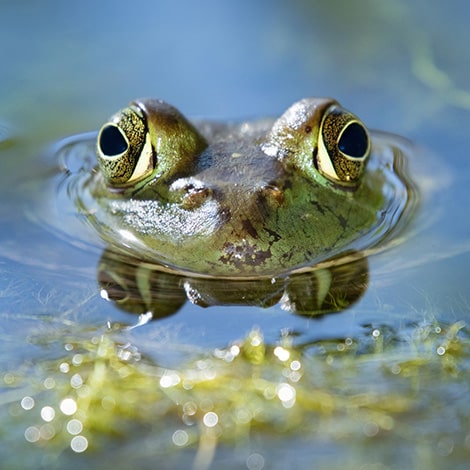A: The answer depends on the age of the frog. As tadpoles, they mainly stick to algae. When bullfrogs and leopard frogs mature into adulthood, they feed on a variety of insects, plants, mites, worms, and even smaller frogs. Green frogs, meanwhile, stick mainly to insects. Most frogs, regardless of type, are not picky and will eat whatever prey can fit into their mouths.
Do Frogs Eat Fish?
Fish aren’t usually a first choice for frog food. Frogs tend to be opportunistic, and insects are easier prey. That being said, frogs will occasionally eat fish that are smaller than them. Bullfrogs and leopard frogs are large enough to consume small or medium-sized pond fish such as goldfish or smaller koi.
Why Keep Pond Frogs?
Pond frogs can be a welcome addition to any backyard, particularly when there is a mosquito problem. Mosquitoes are a quick meal for hungry frogs. If you’re interested in chemical-free mosquito and pest control, pond frogs are one option.
There are other benefits, too. Over time, the frogs in your pond will reproduce and create a steady supply of tadpoles. Algae-eating tadpoles help keep the surface of your pond clean, improving overall water quality and creating a healthier environment for both pond fish and frogs.
Keeping Fish and Frogs Together
It is indeed possible to have a backyard frog pond while still keeping your fish safe. The key is to keep fish and frogs that are similar in size. Large goldfish, most types of common pleco, adult koi, and other larger species of pond fish are safe from most frogs.
How Do Frogs Find Backyard Ponds?
You may be wondering how to attract frogs to your pond. One way to naturally increase your frog population is to create a frog-friendly environment.
- Add plants. Frogs require a variety of plants for both shade and shelter, such as lily pads, ferns, and pond grass. Make sure your backyard pond has enough vegetation to support your pond frog population.
- Create additional shelter. Shelter provides a spot for frogs to cool down as well as to stay safe from birds and other predators. While plant life can serve as a natural shelter, artificial frog houses are also easy to make. Take a few small flowerpots and turn them sideways, then bury the bottoms in dirt to secure them to the ground. This creates a space where frogs can hide.
- Reduce chemical usage. Frogs are highly sensitive to chemicals that may be present in water. If you are using fertilizers, pesticides, algaecides, and other chemicals, you may need to find a natural alternative. Fortunately, frogs can help serve the same purpose as certain pond chemicals. For example, you may find you don’t even need pesticides because pond frogs are so effective at eating any nearby insects.
One other way to increase your pond’s frog population is to introduce them yourself. Adding live tadpoles to your pond is quick and easy. The tadpoles come in a water-filled bag. Simply place the bag in your pond for 10-15 minutes to acclimate the tadpoles. Then remove the bag and put the tadpoles into your pond.
Frogs may be a welcome addition to your backyard, but getting your pond frog-ready can take some work. If you aren’t sure where to start, our experts can help.
Read More Articles
Will Last Year’s Tadpoles Turn Into Frogs?
Protecting Frogs for Winter
Bullfrog and Toad Lifecycle
Last Updated: September 5, 2023
